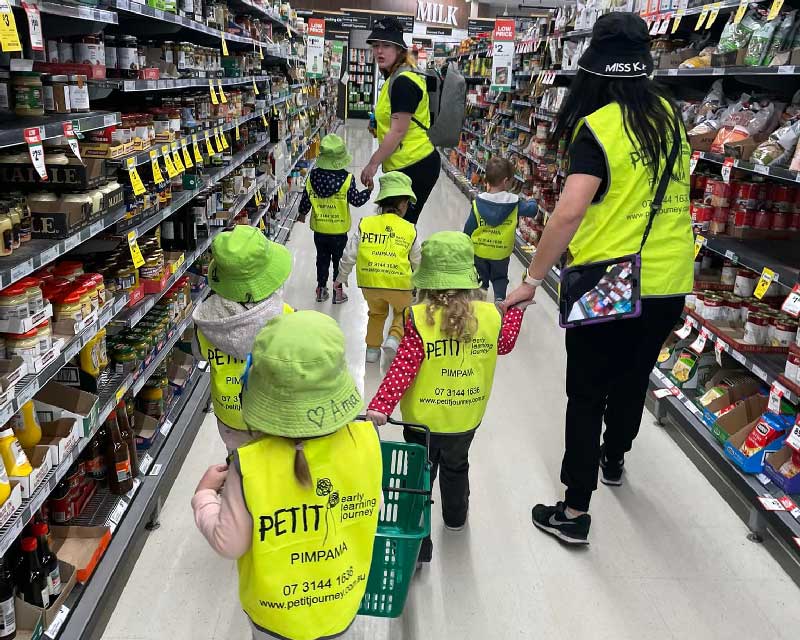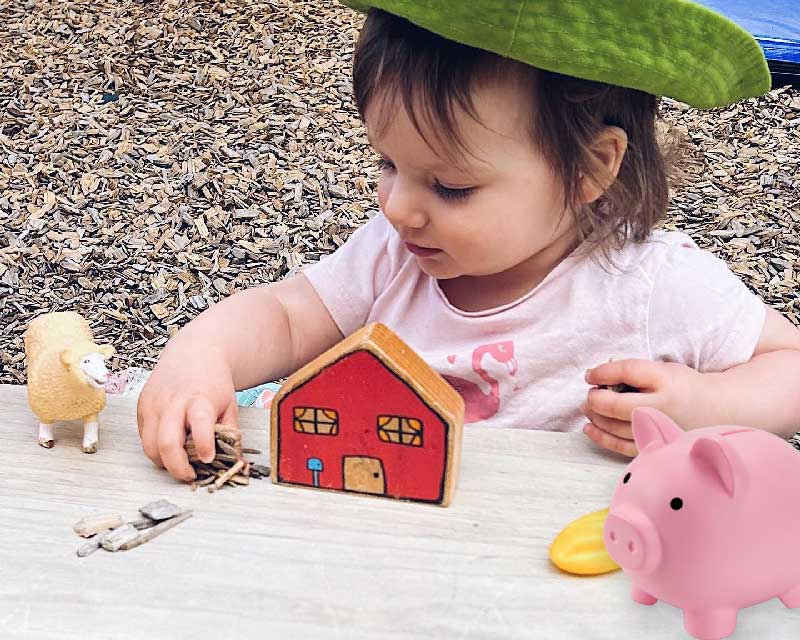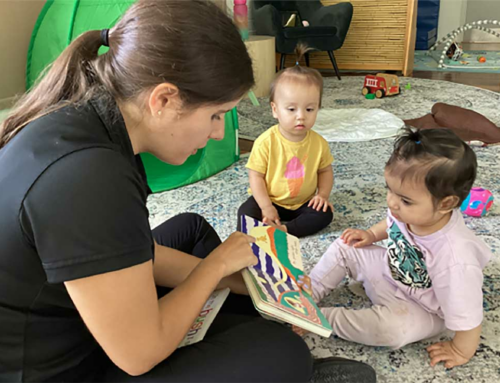Piggy banks, also referred to as money boxes or coin banks, are a clever way to inspire children to develop an interest in saving money. Putting away a few coins each week can encourage children to learn about the importance of money and instil healthy financial habits that can last a lifetime.
One of the simplest and most effective ways to introduce pre-schoolers to saving money is through the classic money box. By showing them how to save in their early years, we can inspire them to move toward a lifetime of financial success.
There are tons of creative piggy bank ideas out there which you can create together with your child, using simple materials from around the home. With these strategies, you can guide your children towards a sustainable, financially responsible future.
In this article, we cover financial literacy and life skills for children including:
- The importance of introducing children to personal finance, budgeting and saving money
- 10 Steps on how to encourage your child to save using a piggy bank
- Games to learn about money
- How to make a DIY piggy bank without breaking the bank

The importance of showing children how to budget and save money
Teaching children the value of money and how to save from a young age is an important life skill. It will provide them with a foundation to become financially responsible adults. Saving money provides children with a tangible way to see their progress and learn about budgeting.
Learning about money can encourage children to:
- Learn about numbers
- Help them count
- Develop a growing understanding of the value of money, products and services
- Broaden their knowledge of where money comes from and where it goes
- Learn how to save and shop
- Experience banking their money and grow their sense of community
- Help with family household budgeting
- Practise handling debt, credit and investing
- Put money aside for an emergency fund
Families can guide children to learn how to save money and then use it for what they really need. Saving starts with setting goals, learning to prioritise spending to improve a person’s financial situation.
Learning to save money can help children grow into financially independent and secure adults. Inspiring children to budget and manage their own funds helps them to develop good spending habits.

How to encourage children to save money using a piggy bank
1. Introduce the concept of money: Start by explaining to your children what money is, how it is earned, its value and how to keep their money safe. Talk to them about different denominations and their worth. This will help them understand the importance of saving.
2. Set savings goals: Encourage your children to set savings goals. It could be saving for a new toy, a special outing, or even a long-term goal like college. By having something specific to save for, they will be motivated to put money into their piggy bank regularly.
3. Provide a piggy bank: Get a coin money bank for your child and explain its purpose. A transparent coin bank helps children to see their savings growing. This visual representation will make saving more exciting for them.
4. Inspire the habit of saving: Encourage your child to save a portion of any money they receive, such as allowance or gifts. Help them to develop a habit of putting a small amount into their piggy bank regularly. This will show them the importance of consistency and discipline in saving money.
5. Reward saving milestones: Celebrate when your child reaches savings milestones. For example, when they save a certain amount, take them out for a treat or let them choose a small reward. This positive reinforcement will motivate them to continue saving.
6. Involve them in budgeting decisions: As your child grows older, involve them in family budgeting discussions. Give them a voice. Invite them to help you shop. Involve them in learning about expenses, budgeting, and the importance of saving for future needs. This will help them understand the value of money and make informed financial decisions.
7. Encourage entrepreneurship: Encourage your child to explore ways to earn extra money, such as doing extra chores or helping out with a garage sale by selling toys and clothing they no longer need. While children’s lemonade stands are rare in Australia, what other ways can children make pocket money in your neighbourhood?
8. Encourage delayed gratification: Help your child understand the concept of delayed gratification. Explain that saving now will allow them to afford bigger and better things in the future. This will inspire patience and self-control, important qualities for financial success.
9. Open a savings bank account: As your child grows older, consider opening a bank account for them. This experience will encourage them to learn about banking, interest, and the benefits of saving in a formal financial institution. It will also provide them with a safe place to store their savings.
10. Read children’s picture books about money:
- Bunny Money by Rosemary Wells.
- Lemonade in Winter: A Book About Two Kids Counting Money by Emily Jenkins (Author), G. Brian Karas (Illustrator).
- Kmart’s “Learning about Money” is a learning resource for 4 years and up based on Australian currency.

Children’s games to learn about money
Money is a complex concept for children to understand, but showing them the basics of budgeting and saving can help to set them up for success. One way to start this process is with money games. Games can be a fun and effective way to show children how money works and how to make smart personal financial decisions.
Save the piggy bank
One game that is great for explaining money to children is called “Save the Piggy Bank.” It is a game that inspires children to learn about budgeting and saving their money in a fun and engaging way. The goal of the game is to help kids understand how to manage their finances and make wise spending decisions.
To play, each child starts with an empty coin bank and a few pretend coins or bills. They then take turns brainstorming ways they can save money and fill their coin money banks. Each child can take turns to express their financial goals
Monopoly or Monopoly Jr
“Monopoly” or “Monopoly Jr” by is also a great board game recommended by NSW Government Education for inspiring children to understand money and maths especially when they are the banker. This classic board game helps children understand about rent, budgeting, negotiations and earnings.
Pretend games using pretend money
Playing pretend games that involve shopping, banking or earning money, buying tickets to home theatre presentations with pretend money is also a fun way to learn about how money makes the world go round.
Sorting the Piggy Bank
“Sorting the Piggy Bank” sets children up to understand how much they have saved before they take it to the bank. Give you child a six paper plates to sort out each denomination, such as 5 cents, 10 cents, 20 cents, 50 cents, one dollar and two dollar coins (using Australian coinage).
Then, once your child has mastered the art of sorting, you can encourage them to level up and stack the coins in towers of 5 or 10 coins. Families may need to help younger children tally up their coins until they’re confidence with counting grows.
Give them a piece of paper divided into six squares for each type of coin. In the squares they can show how many stacks they have and how many left over, either by using numbers or tallying. Help your child to stack, tally and add the coins in the following groups:
- 5 cent pieces stacked by 10 coins equals $0.50.
- 10 cent pieces stacked by 10 coins equals $1.00.
- 20 cent pieces stacked by 5 coins equals $1.00
- 50 cent pieces stacked by 10 coins equals $5.00
- $1 coins stacked by 5 coins equals $5.00
- $2 coins stacked by 5 coins equals $10.00
Finally, add up the stacks and left over coins. This is a fabulous accounting system for the child to take with them when they deposit their money into a savings bank account.

How to make a DIY piggy bank
Making an DIY piggy bank is an easy and fun way to inspire your child to put aside money for a savings account. Not only can it encourage them to start putting away some of their allowance or birthday money for a rainy day, but it will also give them the satisfaction of creating something that they can use as their own personal savings tool.
To make your own money jar you will need:
- An empty glass bottle, or plastic jar for an unbreakable plastic money bank (such as a coffee, Vegemite or jam jar ideal for repurposing into a coin bank).
- A thick piece of paper or bendable cardboard large enough to cover the jars top and be secured with an elastic band.
- An elastic band.
First, cut out the thick piece of paper. You can cut it into a circle or a square to fit the shape of your jar. Create a larger shape than the jar’s opening so that you can secure it as a lid for the money box.
Then cut a coin slot in the piece of paper. It should be wide enough to slide a 50 cent through, as this is the largest coin we use in Australia.
Secure the piece of paper or bendable card board over the top of the jar with an the elastic band.
You might be able to repurpose elastic bands from takeaway sushi containers.
Finally, push a coin through the slot in the piece of paper and watch your money savings grow.
Your child may also be inspired to decorate the jar into an adorable “piggy bank” with googly eyes, permanent markers, construction paper, felt, wool and pink ribbon.
Supporting children to save money with a homemade piggy bank is a valuable experience that will benefit them for a lifetime. By introducing them to the concept of currency, setting savings goals, and providing a visual representation of their progress, we can help children learn about money and inspire them to save from an early age.

Inspire your child with Petit Early Learning Journey
The learning environment is one of the most important aspects at Petit ELJ. It is a place brimming with potential, where we nurture children’s interests and invite them to explore new opportunities. Our spaces are specifically designed to ignite critical thinking, problem solving, and creativity.
We believe that supportive, engaging, and experienced educators are essential for a positive learning environment. Our qualified teaching teams collaborate to help your child feel motivated and connected. Visit your nearest centre now and partner with us to create an amazing learning program that always puts children first.






